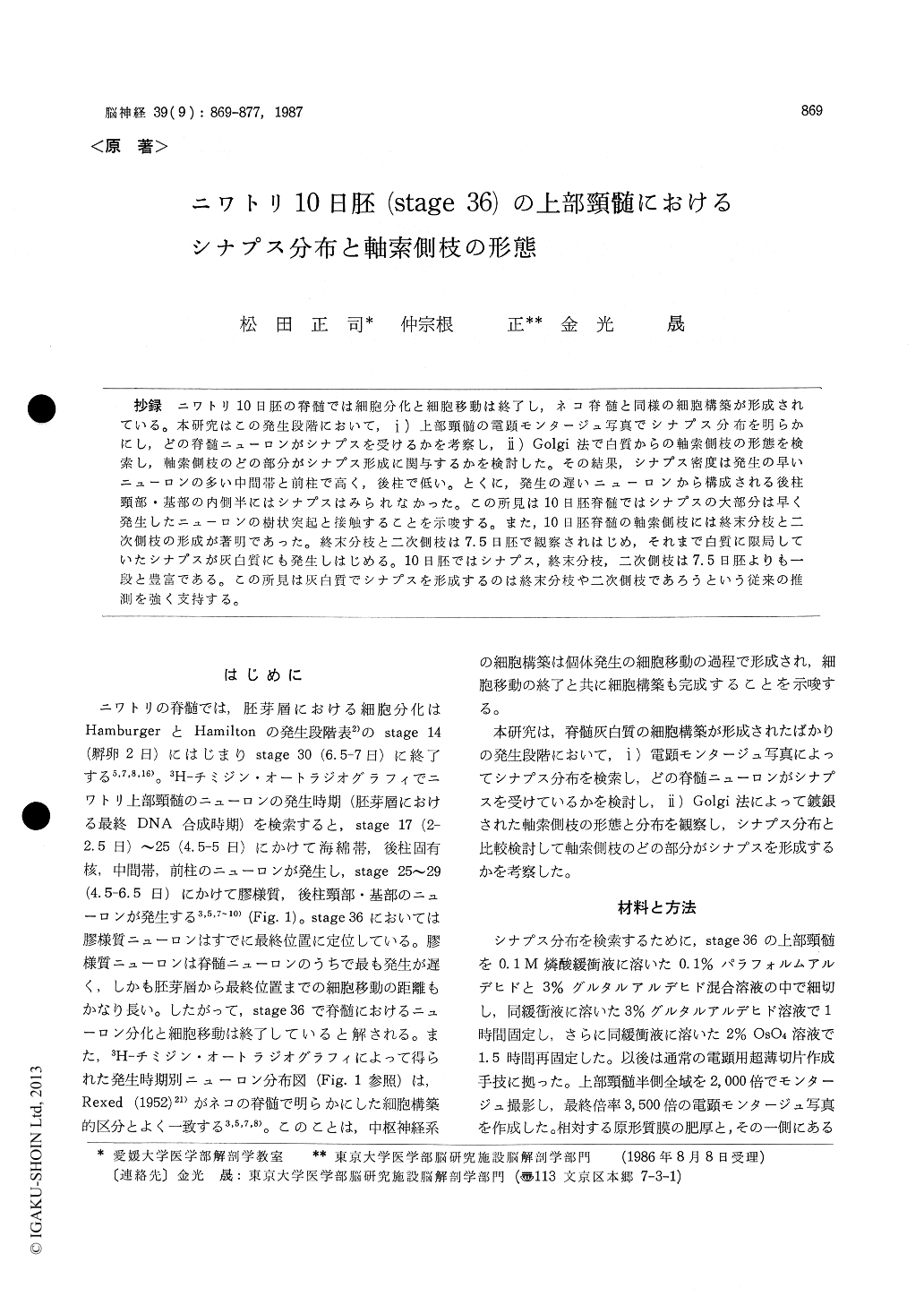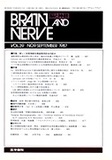Japanese
English
- 有料閲覧
- Abstract 文献概要
- 1ページ目 Look Inside
抄録 ニワトリ10日胚の脊髄では細胞分化と細胞移動は終了し,ネコ脊髄と同様の細胞構築が形成されている。本研究はこの発生段階において,i)上部頸髄の電顕モンタージュ写真でシナプス分布を明らかにし,どの脊髄ニューロンがシナプスを受けるかを考察し,ii) Golgi法で白質からの軸索側枝の形態を検索し,軸索側枝のどの部分がシナプス形成に関与するかを検討した。その結果,シナプス密度は発生の早いニューロンの多い中間帯と前柱で高く,後柱で低い。とくに,発生の遅いニューロンから構成される後柱頸部・基部の内側半にはシナプスはみられなかった。この所見は10日胚脊髄ではシナプスの大部分は早く発生したニューロンの樹状突起と接触することを示唆する。また,10日胚脊髄の軸索側枝には終末分枝と二次側枝の形成が著明であった。終末分枝と二次側枝は7.5日胚で観察されはじめ,それまで白質に限局していたシナプスが灰白質にも発生しはじめる。10日胚ではシナプス,終末分枝,二次側枝は7.5日胚よりも一段と豊富である。この所見は灰白質でシナプスを形成するのは終末分枝や二次側枝であろうという従来の推測を強く支持する。
Our previous study with 3H-thymidine auto-radiography3,8) showed that neurons of the zona spongiosa, the nucleus proprius of the dorsal horn, the zona intermedia and the ventralhorn differen-tiated earlier than those of the substantia gela-tinosa and the neck and the base of the dorsal horn, and that neurons of the substantia gelatinosa which were the last to differentiate reached their final position at stage 36 (Fig. 1). In the upper cervical cord of chick embryos at stage 36 when all spinal neurons finished cell migration and the cytoarchitecture similar to that of the cat spinal cord (Rexed, 1952)21) could be recognized (cf. Figs. 1, 3 B), we studied the distribution of synapses by the electron microphotomontage (Fig. 3 A) and the morphology of axon collaterals coming from the white matter by the Golgi method (Fig. 4), in order to examine i) which spinal neurons have synaptic contacts at this stage and Il) what part of the axon collateral makes synaptic contacts. In the white matter, synapses were numerous around the gray matter and they were few in the peripheral part along the external surface of the cord. The paucity of synapses in the periphe-ral part was explained by a finding that dendrites reaching the external suface of the cord were few in number at this stage (cf. Fig. 3 C). In the gray matter, synapses were more numerous and denser in the zona intermedia and the ventral horn than in the dorsal horn. All synapses were of axodendritic type in the gray matter as well as in the white matter, so that from the distri-bution of synapses alone it was impossible to determine which neurons had synaptic contacts. However, the presence of synapses in a high density in the zona intermedia and the ventral horn where early differentiated neurons were abundant and the absence of synapese in the medial part of the neck and the base of the dorsal horn which was exclusively composed of late differentiated small neurons with short dend-rites might suggest that a greater part of syna-pses observed at this stage made contacts with the dentrites of early differentiated neurons.
Most axon collaterals coming from the white matter had secondary collaterals in their proximal, middle or distal part, and sometimes tertiary col-laterals were observed to sprout out of fairly long secondary collaterals, and many axon col-laterals showed terminal ramifications (Fig.4). Our previous Golgi study showed that the initial dendrite grew rapidly in the beginning and its growth slowed down gradually in the later stages when later growing dendrites protruded from the cell body and branches sprouted out of the initial dendrite. From these findings on the growth of dendrites, it might be assumed that the appearance of secondary collaterals and terminal ramifications reduced the growth of their mother axon col-ateral, and that axon collaterals with secondary collaterals and terminal ramifications reached their target regions.
Secondary collaterals and terminal ramifications appeared first at stage 32, and at stage 33 syna-pses were observed in a low density all over the spinal gray matter except the medial part of the neck and the base of the dorsal horn14,15). At stage 36 secondary collaterals and teminal ramifications were more abundant than at stage 32, and synapses were more numerous than at stage 33. These findings would confirm the pro-posal by Cajal (1890)19) that synapses were made by secondary collaterals and terminal ramifications.

Copyright © 1987, Igaku-Shoin Ltd. All rights reserved.


